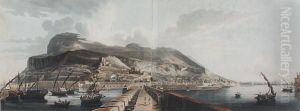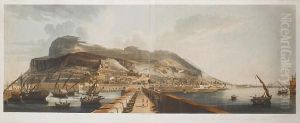Henry Aston Barker Paintings
Henry Aston Barker was a prominent British painter, known especially for his work in the medium of the panorama, which was a popular form of entertainment in the late 18th and early 19th centuries. Barker was born in 1774 in Glasgow, Scotland, and he was the son of the engraver Robert Barker, who is credited with inventing the panorama. Henry Aston Barker grew up surrounded by the arts and was heavily influenced by his father's work.
Barker's primary contribution to the art world was through his work on these large-scale panoramic paintings. He began working with his father at a young age, and after his father's invention of the panorama, he played a significant role in the development and popularization of the form. Panoramas were immersive 360-degree representations of landscapes, battles, and historical scenes that were displayed in circular buildings specifically designed for exhibiting these works. These paintings were intended to give viewers the sensation of being present in the depicted scene, and they were a precursor to modern-day immersive visual experiences.
During his career, Henry Aston Barker traveled extensively to sketch and gather inspiration for the panoramas he would later paint. Some of his most famous works include panoramas of the Battle of Waterloo, the city of Constantinople (now Istanbul), and Athens. These works were exhibited in the Panorama, Leicester Square, London, which was managed by his father and later by Barker himself.
After his father's death in 1806, Barker took over the business and continued to produce and exhibit panoramas. He became quite successful and was recognized for his artistry and innovation in the field. His works were not only popular in Britain but were also exhibited in various cities across Europe, bringing him international acclaim.
Despite the popularity of panoramas during his lifetime, the advent of photography and moving pictures gradually led to the decline of this form of entertainment. Henry Aston Barker's contributions, however, were significant in the context of visual culture, and his panoramas influenced the way people saw and represented the world in art. He captured a pivotal moment in the history of visual media, bridging the gap between traditional painting and what would eventually become immersive cinematic experiences.
Henry Aston Barker lived during a time of great change and innovation, and his work reflects the fascination of that era with new ways of seeing and representing the world. He died in 1856, leaving behind a legacy as one of the key figures in the history of the panorama and as an important artist in the context of British and European art history.

